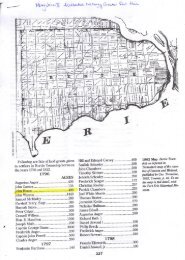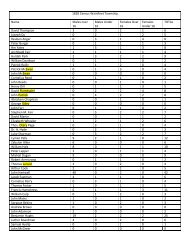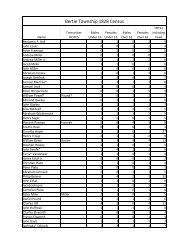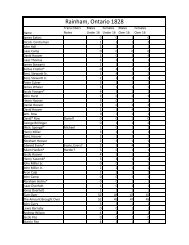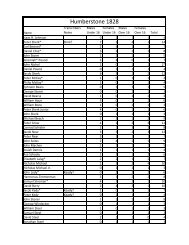The Francis Diller Family - Crego-Jones Family History
The Francis Diller Family - Crego-Jones Family History
The Francis Diller Family - Crego-Jones Family History
- No tags were found...
Create successful ePaper yourself
Turn your PDF publications into a flip-book with our unique Google optimized e-Paper software.
THE FRANCIS DILLER FAMILYBy J. S. <strong>Diller</strong>, Geological Survey, Washington, D. C. <strong>The</strong> descendants of <strong>Francis</strong> <strong>Diller</strong> in Americahave good reason to heartily congratulate themselves in the possession of the original passport whichhe brought with him to this country. It contains the earliest authentic and the only definiteinformation we have, thus far, concerning his life in his native land.<strong>The</strong> following translation of the passport was made by Robert Stein:THE PASSPORTWe Charles Tissot, Mayor of Chaux‐deFonds, in the county of Neuchatel and Valangin inSwitzerland, in the name and on the part of His Majesty the King of Prussia, our Sovereign Prince andLord, make known that Francois‐Louis‐Esaie‐ ? ‐Jean Tueller of Biglen bailiwick of Siguenau(Signau), in the lands of their Excellencies (LL, EE.) of Bern, having sojourned at the said Chaux‐de‐Fonds during the space of about eleven consecutive years, holding by lease a considerable estate,belonging to one and the same private individual, and desiring to go and establish himself elsewherein foreign lands, he has asked us for a passport, with a certificate, to show what has been his conductall the time he has been among us. Accordingly we certify that yhe said Tueller has always conductedhimself as a man of good character and honor, having lived in peace with everyone and that he hasnever committed, either himself or his family, anything that might be reprehensible, which we declareabove, so far as it is wihin our knowledge; also that the design he has formed of establishing himselfelsewhere is due to his own impulse and not to any necessity ti leave this place, whereupon, desiringto favor him so far as it may depend on us, we pray and request all Lords. Governors, Magistrates,Officers and all those that are to be requested, both ecclesiastics and civilians and military men, thatthey may be pleased to grant to said Tueller and to his family all the succor, aid, counsel andassistance which he may need, without subjecting or allowing them to be subjected to any hindrance:with offer made by us, to render the reciprocal treatment to those who may have concourse to us,provided with such certificates and passports. In witness whereof we have here placed the seal of ourArms and have ordered the Registrar of this Jurisdiction to sign it with his ordinary Signature. At thesaid Chaux‐de‐Fonds, Wednesday the tenth day of April, one thousand, seven hundred and fifty four.by order P. SANDOS: (Signature and scroll)THE NAME OF FRANCIS DILLER<strong>Francis</strong> ‐ Louis ‐ Esaie Heu Jean Tueller is the name of our great ancester as it appears in the passportand it seems unusually long, but considering the time and place it is said to have been in accord withcommon usage.Her, the part of the name omitted by Mr. Stein in his translation, probably represents what theFrenchman who wrote this passport intended for Uriah. Louis and Esaie have never been used againas Christian names in the family. Uriah occurs a number of times later. John (Jean) and <strong>Francis</strong> aremost frequently used.HISTORY AND TRANSLATION OF PASSPORT<strong>The</strong> passport is beautifully written in French upon vellum. It passed in succession by inheritance fromFranceis (1) to <strong>Francis</strong> (2) <strong>Francis</strong> (6) and Samuel (26). my father, who had it translated by MissMatilda P. Watts, a sister of Judge Watts in Carlisle, Pa.<strong>The</strong> original passport was given to the Historical Society of Buffalo, N.Y., at the request of my uncleJohn Dill (28) of that city ʺfor safe keeping and convenient reference of the <strong>Diller</strong>s about Buffalo,ʺ but it
was soon lost among the papers of the Historical Society and remained so for forty years untilrecently through the influence of the Carnegie Institution it has been sought for, found, and inexchange for a price restored to the <strong>Diller</strong> archives.Robert Stein, an official translator for the government, made a careful translation of the passport anddiscovered that the native town of our progenitor is not Cigle, as noted by Miss Watts, but Biglen,which is situated among the foothills of the Alps (Bernese Oberland) about 13 1/2 kilometer or 5 1/2miles east of the city of Bern.In reading the passport one should ever bear in mind that it was written by a Frenchman whorecorded what he was told by <strong>Francis</strong> Tuller in German. Owing to a fold in the passport the final letterin the name of the ancestral town is blurred. <strong>The</strong> bailiwick of Signau is certain and there is scarcely adoubt that Piglen (?) represents the Frenchmanʹs interpretation of the German pronunciation of Biglen.At any rate there is no other name excepting Biglen in the vicinity of Signau to suggest identity and Ihave complete confidence in Mr. Steinʹs determinations.BIGLENBiglen, the native place of <strong>Francis</strong> <strong>Diller</strong> (1), nestles among the rolling hills of the lake region in thevery heart of northwestern Switzerland. It is drained by the Aar, one of the tributaries of the historicRhine, and has an elevation of about 2500 feet above the sea. Forty miles away to the northwest aboutChaux‐de‐Fonds rise the regular ridges of the Jura Mountains, while to the southeast in plain viewforming a magnificient panorama are the snow capped peaks of the Bernese Alps which afford someof the finest scenery of the world and are annually visited by many thousands of tourists from allparts of the globe. <strong>The</strong> immediate vicinity of Biglen is given over chiefly to agriculture andhorticulture, supplying a dense population and large number of travelers.PERSECUTION OF THE MENNONITES IN SWITZERLAND<strong>The</strong> history of Switzerland is preeminently one of conflict, civil and religious, and her people may wellfind gratification in the scars their families have borne in the cause of righteousness.It is evident that <strong>Francis</strong> <strong>Diller</strong> (1) spent the early years of his life up to 1743 when he reachedmanhood, in the canton of Bern, Switzerland, where the moral struggle was most intense, and it isimportant that we should appreciate as fully as possible the circumstances of his youth. He was aMennonite, and in those days it required peculiarly strong courage and devotion to join such a cause.<strong>The</strong> hostility of the established church, which was the chief source of trouble, is so well stated by Prof.C. Henry Smith in his account of the Mennonites of America that I quote his words as follows:ʺ<strong>The</strong> cause of this hostility on the part of the established church was largely the attitude of theMennonites toward a state church and their non‐participation in civil government. <strong>The</strong>y taught thatstate and church must be independent of each other, and refused to bear arms, take the oath, and holdoffice. Misunderstood on these questions they were considered dangerous questions they wereconsidered dangerous by both the state and church and were hounded to death by both. At first theyhunted like wild beasts, burned at the stake, drowned in the rivers, or left to rot in filthy prisons. Asthe spirit of the times became more humane during the seventeenth century they were exiled from thecountry, sent to the galleys and their property confiscated. In the eighteenth century they werepunished with a money fine and denied many of the rights of citizenship.ʺ <strong>The</strong> persecutions weremost intense and long continued in Bern, and it is probable that <strong>Francis</strong> <strong>Diller</strong> (1) was among thoseexiled from his native land for we find him at La Chaux‐de‐Fonds during the last 11 years of hissojourn in Europe under the King of Prussia, who had invited the exiled Bernese to settle in his ownterritory.
FRANCIS DILLER IN SWITZERLAND<strong>The</strong> passport informs us definitely concerning <strong>Francis</strong> <strong>Diller</strong> (1) that the place of his nativity is Biglen,that he leased a considerable estate atChaux‐de‐Fonds where he resided continuously for 11 years, and that he was a man of good characterand had a family.It seems evident that he was a farmer and settled at Chaux‐de‐Fonds in 1743. That he remained there11 years is to his credit, for the farmers of that region have a reputation. Baededecker, an excellentauthority, says that this remote and sterile Alpine valley lying nearly as high as the top of Snowden(3590 feet) and imperfectly supplied with water has a population of over 22,000 inhabitants, whoseskill and industry enables them to defy the rigors of a climate where corn only ripens in warmsummers.As his eldes son was born about 1743, tho possibly as early as 1731 if gravestones can be relied on,<strong>Francis</strong> <strong>Diller</strong> (1) was most likely married at Biglen before removing to Chaus‐de‐Fonds, and it isprobable that the other three children were all born during this sojourn of the family at Chaux‐de‐Fonds.THE IMMIGRATION OF FRANCIS DILLER (1)<strong>The</strong> passport was obtained April 10 1754, and it is more than likelythat he started at once on hisjourney down the Rhine, which has ever been the great natural out for the northwestern portion ofSwitzerland. On the way he passed through the border land of Alsace and the Palatinate, but there isno evidence to show that he stopped there or in Holland for any considerable time before sailing forAmerica.Of his journey thither no record has yet been found, but there is a family tradition fairly wellpreserved to the effect that on the ocean voyage his household goods were lost at sea, and the family,so the story runs, was thus reduced to extreme poverty. As out of accord with the traditional viewapparently it may be noted that J. S. Burkhart, of Dickinson, Pa., has a peculiar German bookcasewhich is said to have been brought over by the family. Furthermore, it seems improbable that thefamily arrived very poor from the fact that a few years later <strong>Francis</strong> <strong>Diller</strong> (1) bought a farm payingover $2,000 cash besides assuming a mortgage on the property.FRANCIS DILLER (1) IN AMERICAApril 10, 1760, exactly six years from the date of his passport in Chaux‐de‐Fonds, <strong>Francis</strong> <strong>Diller</strong> (1)(<strong>Francis</strong> Teylor) purchased a farm of 147 acres on a branch of Muddy Creek in Cocalico, nowBrecknock township, Lancaster county, Pa., for 415 oounds cash besides assuming a mortgage of 84pounds. <strong>The</strong> land is part of that nown owned by Joseph Horning, 1 3/4 miles directly north ofBowmansville. His deed is among Mr. Horningʹs papers. In the early years of his residence asmentioned in history <strong>Francis</strong><strong>Diller</strong> (1) erected the first mill in Lancaster county. He operated it during the Revolutionary War anddoubtless supplied his share of ʺthe spirit of 1776ʺ. <strong>The</strong> site of the distillery was pointed out to me in1904 by Tobias Bowman.It is near a spring a short distance south of the house of John Frees, on the land of Mr. Joseph Horning.<strong>The</strong> farm was enlarged. Ellis and Evans <strong>History</strong> of Lancaster county gives a list of the 59 principalland owners of Brecknock township about the close of the Revolutionary War and mentions Abraham
<strong>Diller</strong> (4), the youngest son of <strong>Francis</strong> (1), as having 300 acres. <strong>The</strong>re were at that time only two largerfarms in the township. one with 327 and the other 328 acres.<strong>The</strong> Mennonites being non‐resistant in belief were strongly opposed to the war and would not join thearmy though they willingly paid all taxes imposed by the government for the purpose of the war.What a seemingly strange belief that permitted them to make and sell intoxicating liquors and yetprevented them from taking arms in defense of their country. In the land from which they came,especially among the Germans, the limited but not excessive use of alcoholic beverages was general intheir day and even yet is much more common than in America. We must judge our ancestors not bythe searchlight of the present but by the less discriminating light of their own time.<strong>Francis</strong> <strong>Diller</strong> (1) made his will November 12, 1782, naming his son Peter as executor. <strong>The</strong> will is thefirst document in which the modern spelling of the family name, <strong>Diller</strong>, has yet been found, and Peter<strong>Diller</strong> (3) was the earliest of the family to write his own signature.<strong>The</strong> will of <strong>Francis</strong> <strong>Diller</strong> (1) is a model of its day in the care shown in providing for the survivingwidow.<strong>Francis</strong> <strong>Diller</strong> (1) died soon after his will was made and he was buried probably at the MennoniteMeetinghouse in Bowmansville. <strong>The</strong> late Tobias Bowman and I searched for the grave but failed toidentify it.THE FRANCE DILLER (1) BIBLE<strong>The</strong> great book of the <strong>Francis</strong> <strong>Diller</strong> (1) kinship is the Bible which has been transmitted with thepassport to Samuel <strong>Diller</strong> (26). In memory of a devout ancestry this Bible has been presented to theLibrary of Congress, Washington, D. C., where it is catalogued not only as the <strong>Diller</strong>, <strong>Francis</strong>, Biblebut also under Bible‐German‐1744.<strong>The</strong> book is big enough to affirm its own antiquity. It is 14 1/2 inches long, 10 1/2 inches wide and 4inches thick, with wooden lids bound in pigskin leather surmounted by brass corners, clasps andcenter plates, and weighs 13 pounds. <strong>The</strong> front center plate bears the impressed letters VB and the back center plate has the number 1754, the date of migration from la Chaux‐de‐Fonds.<strong>The</strong> letters V B are supposed by C. Mertel and other authorities in the Library of Congress to be theinitials of the original owner when it was bound in Europe in 1754. If this be true this great book mayhave belonged originally to the Bowmans or the Boehms.It is a rather remarkable fact that Wendel Bowman, who immigrated in 1709 and settled in PequeaValley, is my great‐great‐great grandfather thru both my father and my mother along two lines ofdescent for the most part entirely distinct. It is equally remarkable that the initials V B are essentiallythose of Wendel Bowman, but no definite connectiong trace has as yet been found.<strong>The</strong> Bible contains no family record but it has been kept with the passport, according to tradition, eversince <strong>Francis</strong> <strong>Diller</strong> (1) came over in 1754.It is a Froschauer Bible, being a reprint at Strassburg in 1744 of the edition issued by ChristoffelFroschauer at Zurich in 1536. Daniel Rupp, in his history of Lancaster county, calls attention to theexistence of a number of similar Bibles among the Mennonites, and I will think anyone very much forinformation, thru this magazine or directly, as to where any such Bibles may be seen.<strong>The</strong> family came to Philadelphia in America from Rotterdam aboard the Phoenix in 1754 with thefamily listed under the name of Frans Tieler



